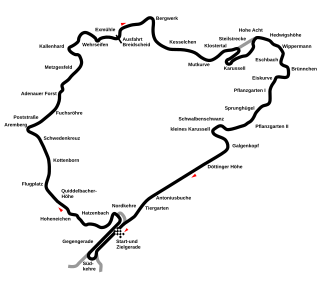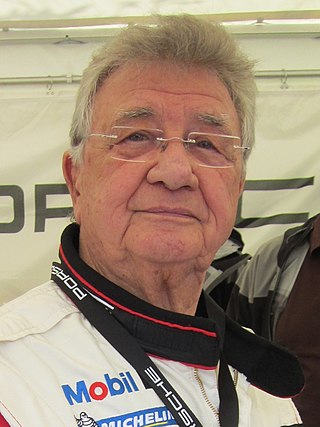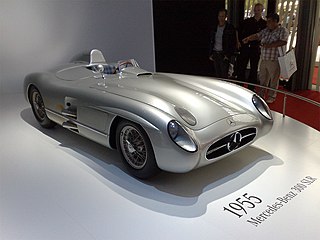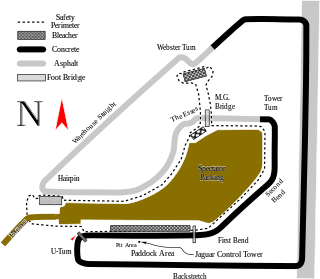
Pierre Eugène Alfred Bouillin was a French sportsman and racing driver. He took the racing name Pierre Levegh in memory of his uncle Alfred Velghe, a pioneering driver who died in 1904. Levegh died in the 1955 Le Mans disaster which also killed 83 spectators during the 1955 24 Hours of Le Mans automobile race.

Alfred Neubauer was the racing manager of the Mercedes-Benz Grand Prix team from 1926 to 1955.

The 1954 German Grand Prix was a Formula One motor race held at Nürburgring on 1 August 1954. It was race 6 of 9 in the 1954 World Championship of Drivers. It was the 17th German Grand Prix since the race was first held in 1926 and the 16th to be held at the Nürburgring complex of circuits. The race was won by 1951 world champion, Argentine driver Juan Manuel Fangio driving a Mercedes-Benz W196. Ferrari 625 drivers Mike Hawthorn and Maurice Trintignant finished second and third for Scuderia Ferrari.
The 1955 Formula One season was the ninth season of FIA Formula One motor racing. It featured the 1955 World Championship of Drivers, which commenced on 16 January 1955 and ended on 11 September after seven races. Juan Manuel Fangio won his second consecutive World Championship title in a season curtailed by tragedies.

Hans Herrmann is a retired Formula One and sports car racing driver from Stuttgart, Germany.

Karl Kling was a motor racing driver and manager from Germany. He participated in 11 Formula One Grands Prix, debuting on 4 July 1954. He achieved 2 podiums - the first German ever to achieve a Formula One podium - and scored a total of 17 championship points.

The Jaguar D-Type is a sports racing car that was produced by Jaguar Cars Ltd. between 1954 and 1957. Designed specifically to win the Le Mans 24-hour race, it shared the straight-6 XK engine and many mechanical components with its C-Type predecessor. Its structure, however, was radically different, with innovative monocoque construction and slippery aerodynamics that integrated aviation technology, including in some examples a distinctive vertical stabilizer.
John Cooper Fitch was an American racing driver and inventor. He was the first American to race automobiles successfully in Europe in the post-war era.

The Mercedes-Benz 300 SLR (W 196 S) is a two-seat sports racing car that took part in the 1955 World Sportscar Championship before a catastrophic crash and fire at Le Mans later that year ended its domination prematurely. The car was designated "SL-R", which was later condensed to "SLR". Technically, the W 196 S is based on the W 196 R, but has a slightly different engine, displacing 3 litres.

The 1955 Le Mans disaster was a major crash that occurred on 11 June 1955 during the 24 Hours of Le Mans motor race at Circuit de la Sarthe in Le Mans, Sarthe, France. Large pieces of debris flew into the crowd, killing 83 spectators and French driver Pierre Levegh, and injuring around 120 more. It was the most catastrophic crash in motorsport history, prompting Switzerland to institute a nation-wide ban on motorsports altogether that lasted until 2022.

The Mercedes-Benz W196 was a Formula One racing car produced by Mercedes-Benz for the 1954 and 1955 F1 seasons. Successor to the W194, in the hands of Juan Manuel Fangio and Stirling Moss it won 9 of 12 races entered and captured the only two world championships in which it competed.

The 1955 24 Hours of Le Mans was the 23rd 24 Hours of Le Mans and took place on 11 and 12 June 1955 on Circuit de la Sarthe. It was also the fourth round of the F.I.A. World Sports Car Championship. During the race, a crash killed driver Pierre Levegh and 83 spectators while injuring 120 others in the deadliest accident in motor racing history.

The 1953 24 Hours of Le Mans was the 21st Grand Prix of Endurance, and took place on 13 and 14 June 1953, at the Circuit de la Sarthe, Le Mans (France). It was also the third round of the F.I.A. World Sports Car Championship.

The 1952 24 Hours of Le Mans was the 20th Grand Prix of Endurance, and took place on 14–15 June 1952 at Circuit de la Sarthe.
The 1955 World Sportscar Championship season was the third season of FIA World Sportscar Championship motor racing. It featured a series of six endurance races for sportscars, contested from 23 January to 16 October 1955.
Throughout its long history, Mercedes-Benz has been involved in a range of successful motorsport activities, including sportscar racing, touring car racing, Grand Prix racing, and rallying. It is currently active in GT racing, and Formula One.

The 1955 Mille Miglia was a 1,000 mile motor race held on a course made up entirely of public roads around Italy, mostly on the outer parts of the country on April 30-May 1, 1955. Also known as the 22. edizione Mille Miglia, the 992.332 mile (1597 km) route was based on a round trip between Brescia and Rome, with start/finish in Brescia. It was the 3rd round of the 1955 World Sportscar Championship and for the Coppa Franco Mazzotti.

The 1955 RAC Tourist Trophy took place on 17 September, on the roads around Dundrod,. It was also the fifth round of the F.I.A. World Sports Car Championship, however it was the first championship race following the horrendous tragedy at Le Mans. It was also the Golden Jubilee year for the RAC Tourist Trophy. Going into the race, Ferrari were leading the Manufacturers Championship by four points from Jaguar. Victory for the Italian marque would put them in a strong position to win a third successive title.

The 39a Targa Florio took place on 16 October, around the Circuito delle Madonie, Sicily, Italy. It was also the sixth and final round of the F.I.A. World Sports Car Championship as the Carrera Panamericana was cancelled and the Targa was allowed to take the late season slot, as a second Italian round after the Mille Miglia in May. The title lay between Ferrari, Jaguar and Mercedes-Benz, with Ferrari leading 19 points from one win to 16 from the other two marques which had two wins each, but no other results. Mercedes had skipped the first two heats and withdrew from Le Mans after the disaster, while leading the race. Jaguar did not show up in Sicily at the unknown 72 km long road track, but Mercedes came three weeks early to practice with seven cars. Finishing 1-2-4, Mercedes secured the championship.

The 1956 Florida International Grand Prix of Endurance powered by Amoco took place on 24 March, on the Sebring International Raceway,. It was the second round of the F.I.A. World Sports Car Championship. For the sixth running of the event, was a sign to many in the automotive community that this race had become North America's premier sports car race, and from an international standpoint second only to the 24 Hours of Le Mans.















